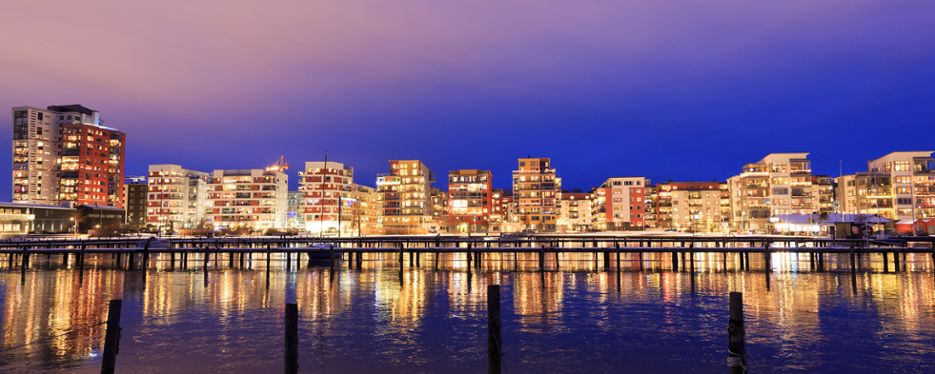Existing buildings and built environments were constructed with previous climatic conditions in mind. The future climate, which will become increasingly warmer and with more extreme precipitation, will require a more sustainable and flexible spatial planning in order to continuously adapt to climatic changes. The development of a long-term robust society is dependent upon preventive spatial planning that reduces vulnerability and takes advantage of new opportunities that arise as a result of a changed climate.
New precipitation patterns require new planning
Rising sea levels will mean that the risk of flooding for buildings and infrastructure in coastal areas will continue to increase. Buildings close to lakes and waterways may be exposed to a greater risk of flooding. This is due to increased precipitation and changes to the onset of melting of snow and ice, which are expected to affect large parts of Sweden. This will likely result in changed water levels and flow regimes in lakes and waterways. In addition to an expected increase in the total amount of precipitation in most of the country, it is also expected that intensive cloudbursts will occur more frequently. This could cause local floodings, with water filled cellars and overloaded of drainage systems as a result.
Heavy precipitation and increased flows in waterways, in conjunction with increased and varying levels of groundwater, could reduce the stability of land, resulting in an increased risk of landslips, landslides and erosion. More precipitation will also increase the risk of damp and fungal damage, and there will be a greater need for maintenance to the exteriors of both new and existing buildings.
The effects of heatwaves on society
Higher average temperatures in Sweden will reduce the need for heating, but at the same time increase the need for cooling in homes and other properties. In the future, heatwaves are expected to occur more frequently and last for longer periods of time. People in larger cities will be particularly vulnerable during heatwaves, as heavily populated areas generate higher temperatures as a result of heat storage – known as the ‘urban heat island’ effect. High temperatures during prolonged periods can have adverse effects on our health. Elderly and sick people as well as young children are particularly vulnerable, which will make the inclusion of temperature-reduction measures in spatial planning, building and renovation more important in a changed climate.
Geographical variations within Sweden
The effects of the changes in climate, and the risks to which buildings and infrastructures may be exposed, will vary throughout the country – for example, rising sea levels are currently of more significance in spatial planning in southern and central Sweden, as the geological uplift in northern Sweden continues to compensate for the rising sea level. In the longer term, however, the increased sea level will also affect the coastal regions in the north.
As a result of changes in snow and precipitation patterns, the spring floods in southern Sweden will disappear entirely, and be replaced with higher water levels in waterways during the winter, whilst there will be an increase in spring floods in the most northerly parts of the country. It is therefore of importance that both the impacts of climate change and the local geographical conditions are well taken into consideration in the spatial planning.
Spatial planning in the longer term
The life expectancy of buildings is an important point for consideration in planning. Buildings and infrastructure that are built today are likely to last for a long time. The life expectancy of a building is at least 50-100 years, and sometimes even longer for infrastructure. Even if the structure of society can be changed, the buildings and infrastructure that are built today will still be around when the effects of the changed climate becomes more tangible.
Most of the various climate scenarios for expected climate change that are currently available extends to the year 2100. The climate will continue to change even beyond that point – for example, global sea levels may continue to rise by a metre or more during the current century, by several metres by 2300, and by many metres as time continues further into the future.
Climate adaptation in planning can result in synergy effects
Climate adaptation measures can create additional added value in society. In sites that are already developed, for example, the surfaces may have a limited capacity to manage large amounts of water in the event of heavy rain. One solution could be multifunctional surfaces – places that are designed to be able to handle large amounts of water on a temporary basis, but that can be used for other purposes during the rest of the time, such as football pitches, parks or play areas.
Vegetation is an important tool in the management of climate-related risks, while also providing other positive effects. Greenery – particularly deciduous trees – lowers temperatures and contributes to a more pleasant climate in cities, while also accommodating water in the event of heavy precipitation. A greener city also allows for greater biodiversity, as well as being a healthier and more attractive place to live.
